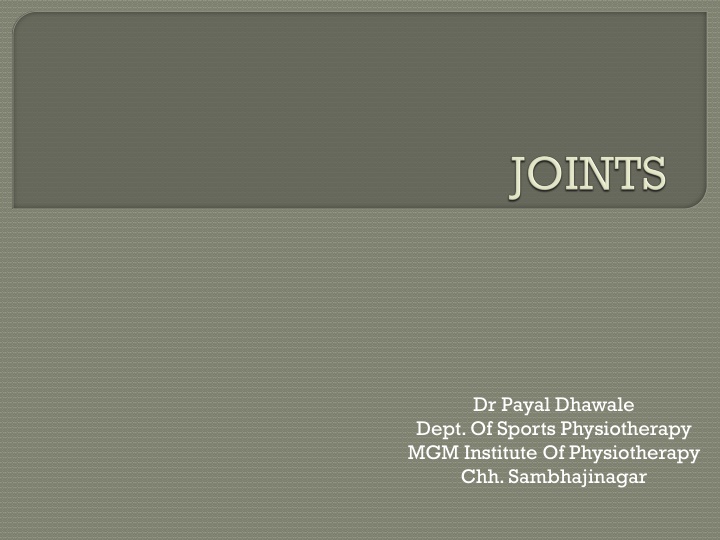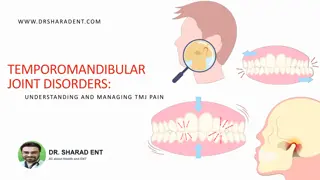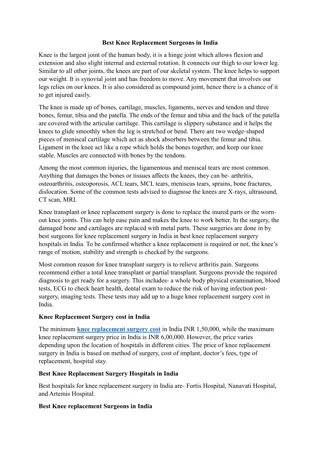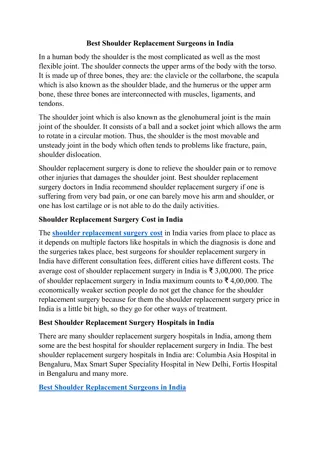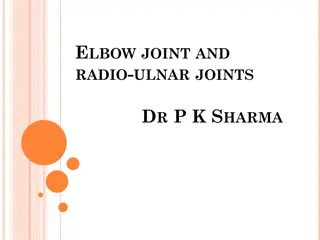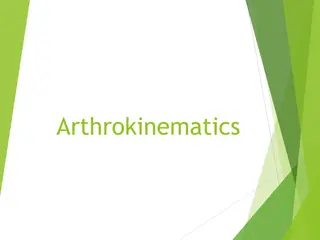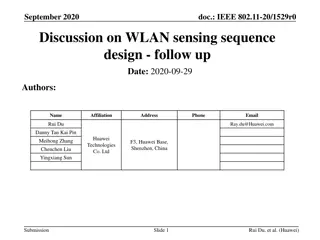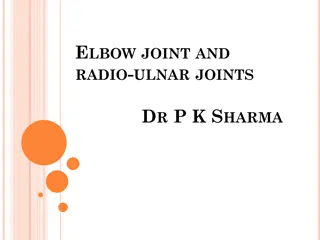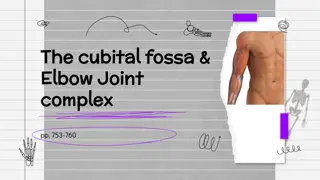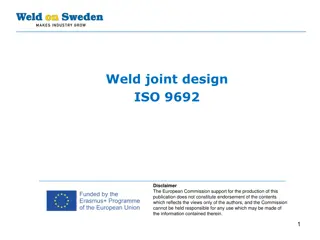Human Joint Design and Function
Human joints vary in complexity, serving dual mobility-stability functions. Capsules, ligaments, tendons provide stability and guide motion. Cartilage wedges enhance stability and shock absorption. Articular joints classified as synarthroses (nonsynovial) and diarthroses (synovial).
Download Presentation

Please find below an Image/Link to download the presentation.
The content on the website is provided AS IS for your information and personal use only. It may not be sold, licensed, or shared on other websites without obtaining consent from the author.If you encounter any issues during the download, it is possible that the publisher has removed the file from their server.
You are allowed to download the files provided on this website for personal or commercial use, subject to the condition that they are used lawfully. All files are the property of their respective owners.
The content on the website is provided AS IS for your information and personal use only. It may not be sold, licensed, or shared on other websites without obtaining consent from the author.
E N D
Presentation Transcript
Dr Payal Dhawale Dept. Of Sports Physiotherapy MGM Institute Of Physiotherapy Chh. Sambhajinagar
Joint designs in the human body vary from simple to complex. Simple human joints stability as a primary function; the more complex joints usually have mobility as a primary function. However, most joints in the human body serve a dual mobility-stability function and must also provide dynamic stability. usually have
The capsules, ligaments, and tendons located around mobility (synovial) joints not only help to provide stability for the joint but also guide, limit, and permit motion.
Wedges of cartilage called menisci, discs, plates, and labra, in synovial joints help increase stability, provide shock absorption,and facilitate motion. A lubricant, synovial fluid, is secreted in all synovial joints to help reduce friction between the articulating surfaces.
The two broad categories of arthroses (Joints) are synarthroses (nonsynovial joints) and diarthroses (synovial joints) JOINTS Diarthroses Synarthroses
The components in synarthrodial joints is interosseous connective tissue (fibrous and/or cartilaginous). material connecting the bony
Synarthroses divisions connective tissue in the union of bone to bone: fibrous joints and cartilaginous joints. Synarthroses are grouped to into type two of according the Cartilaginous Fibrous
In directly connects bone to bone. Three different types of fibrous joints are found in the human body: sutures, gomphoses, and syndesmoses. fibrous joints, the fibrous tissue
Fibrous Joints Sutures Gomphoses, Syndesmoses
The serrated edges of the parietal and frontal bones of the skull are connected by a thin fibrous membrane (the sutural ligament) to form the coronal suture
A gomphosis joint is a joint in which the surfaces of bony components are adapted to each other like a peg in a hole. In this type of joint, the component parts are connected by fibrous tissue. tooth and either the mandible or maxilla.
The shaft of the tibia is joined directly to the shaft of the fibula by an interosseous membrane
The components in cartilaginous joints are fibrocartilage and/or hyaline cartilage. These materials directly unite one bony surface to another, creating a bone- cartilage-bone interface. materials connecting the bony
The two types of cartilaginous joints are symphyses and synchondroses. Cartilaginous Synchondroses (primary cartilaginous joint) Symphyses (secondary cartilaginous joint)
In a symphysis joint (secondary cartilaginous joint), the two bony components are covered with a thin lamina of hyaline cartilage and directly joined by fibrocartilage in the form of discs or pads.
Examples of symphysis joints include the intervertebral joints between the bodies of the vertebrae, the joint between the manubrium and the sternal body, the symphysis pubis in the pelvis
A synchondrosis (primary cartilaginous joint) is a type of joint in which the material used to connect the two components is hyaline cartilage. The cartilage forms a bond between two ossifying centers of bone.
The function of this type of joint is to permit bone growth while also providing stability and allowing a small amount of mobility When bone growth is complete, some of these joints ossify and convert to bony unions (synostoses).
Synovial joints, the ends of the bony components are free to move in relation to one another because no connective tissue directly connects adjacent bony surfaces. The bony components are indirectly connected to one another by means of a joint capsule that encloses the joint.
All synovial joints are constructed in a similar manner and have the following features: (1) a joint capsule that is composed of two layers (2) a joint cavity that is enclosed by the joint capsule (3) synovial tissue that lines the inner surface of the capsule (4) synovial fluid that forms a film over the joint surfaces (5) hyaline cartilage that covers the surfaces of the enclosed contiguous bones
Synovial joints may also include accessory structures, such as fibrocartilaginous discs, plates, or menisci; labra; fat pads; and ligaments.
Excessive separation or translation of joint surfaces is limited by passive tension in ligaments, the fibrous joint capsule, and tendons (passive stability). Active tension in muscles (dynamic stability) also limits the separation or translation of joint surfaces.
Joint capsules vary considerably in both thickness and composition. The joint capsule is composed of two layers: an outer layer called the stratum fibrosum and an inner layer called the stratum synovium
The thin film of synovial fluid that covers the surfaces of the inner layer of the joint capsule and articular cartilage helps to keep the joint surfaces lubricated and reduces friction. The fluid also provides nourishment for the hyaline cartilage covering the articular surfaces, as fluid moves in and out of the cartilage as compression is applied, then released.
synovial fluid also contains hyaluronate (hyaluronic acid) and a glycoprotein called lubricin. The hyaluronate synovial fluid is responsible for the viscosity of the fluid and is essential for joint lubrication. Hyaluronate reduces the friction between the synovial folds of the capsule and the articular surfaces component of
Diarthrodial Subclassifications Traditionally, synovial joints have been divided mechanically into three main categories based on the number of axes about which gross visible motion occurs
Diarthroses Uniaxial Biaxial Triaxial
A uniaxial joint involves visible motion of the bony components in one plane around a single axis. The axis of motion usually is located near or in the center of the joint or in one of its bony components.
Having one degree of freedom of motion. The two types of uniaxial diarthrodial joints found in the human body are hinge joints and pivot (trochoid) joints. Uniaxial Pivot Hinge
pivot (trochoid) joint is a type of joint constructed so that one component is shaped like a ring and the other component is shaped so that it can rotate within the ring. The Median Atlantoaxial Joint
Biaxial diarthrodial joints are joints in which the bony components are free to move in two planes around two axes; these joints have two degrees of freedom. There are two types of biaxial joints in the body: condyloid and saddle.
The joint surfaces in a condyloid joint are shaped so that the concave surface of one bony component slides over the convex surface of another component in two directions. Metacarpophalangeal jt
A saddle joint is a joint in which each joint surface is convex in one plane and concave in the other, and these surfaces fit together like a rider on a saddle. Carpometacarpal jt of thumb-trapezium- first metacarpal
Triaxial or multiaxial diarthrodial joints are joints in which the bony components are free to move in three planes around three axes. These joints have three degrees of freedom. Motion at these joints may also occur in oblique planes.
The two types of joints in this category are plane joints and ball-and-socket joints. Plane joint have a variety of surface configurations and permit gliding between two or more bones.
Plane joints are found between the adjacent surfaces of the carpal bones. The ball and socket joint hip joint is formed by the head of the femur and a socket called the acetabulum
Synarthrodial joints are relatively simple in design and function primarily as stability joints, although some motion does occur. Diarthrodial joints are more complex and primarily provide mobility, though these joints also provide some measure of stability.
Kinematic Chains open kinematic chain closed kinematic chain.
Joint Motion Range Of Motion End-feel-after passive physiologic movements at each jt Hypermobile. Hypomobile.
Osteokinematics Osteokinematics refers to the rotary movement of the bones in space during physiological joint motion
Arthrokinematics Physiological joint motion involves rotation of bony segments (osteokinematics) as well as motion of the joint surfaces in relation to another
The accessory motion, is used to refer to these movements relative to one another. Often, one of the relatively stable and serves as a base for the motion, whereas the other surface moves on this relatively fixed base. term arthrokinematics, or of joint surfaces joint surfaces is
The terms roll, slide, and spin are used to describe the type of motion that the moving part performs.
A roll refers to the rolling of one joint surface on another, as in a tire rolling on the road. In the knee, the femoral condyles roll on the fixed tibial surface during the initial stages of knee flexion or extension in standing.
Sliding, which motion, refers to the gliding of one component over another, as when a braked wheel skids. is a pure translatory
Spin is a pure rotary motion. The point of contact changes component but not for the fixed. At the elbow,the head of the radius spins on the capitulum of the humerus during supination and pronation of the forearm. for the moving
During human joint motion, combinations of rolling and sliding usually occur in order to maintain joint integrity.
